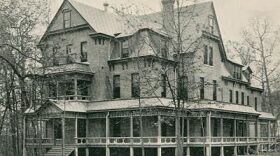Every city has its major streets, often with familiar names like Lincoln or Vine. Then there’s Kalamazoo’s Westnedge Avenue.
“I’m interested in words and the origins and I’d never encountered this word before,” says Kate Kirk-Greenberg, a grief counselor in Kalamazoo, who asked “Why’s That?” how the street got its name.
When something in Southwest Michigan makes you curious, let “Why’s That?” know!
“Like Kate I was as a transplant here and I was fascinated by the name as well,” says Tom George, a physician and former state lawmaker who researches local history.
“Westnedge Avenue is a memorial name,” he explains.
The person it remembers? Joseph B. Westnedge, born in 1872. George says Westnedge and his family lived near Portage Road in what’s now the City of Portage.
Joseph Westnedge had an older brother, Richard. George says the brothers both played football at Kalamazoo College, and each joined Kalamazoo’s unit of the Michigan National Guard.
“And they were both called to service in the Spanish-American War and the older brother Richard was a physician and he died in the Philippines,” George says.
Richard Westnedge died of typhoid fever. The year was 1899 and he was 28 years old. Joseph, the younger brother, came back to Kalamazoo and went to work at a paper mill. George says Westnedge also stayed active in the National Guard.
“He was elected the leader, the captain,” George says, which gave Joseph Westnedge a measure of local prominence.
George says the unit did see action from time to time.
“Including being called to duty to defend the border with Mexico after the raid by Pancho Villa, so they were activated in 1916 raid and served on Mexican border,” he says.
They came back to Kalamazoo but a year later,
“A hundred years ago this spring America entered World War I and declared war on Germany.”
George says the US had relatively few troops ready to go.
“But Kalamazoo’s National Guard, having just returned from the border with Mexico with their arms and their equipment and supplies were activated early.”
George says Kalamazoo followed news of the soldiers closely.
“It was the biggest war event since the Civil War,” he notes.
George says Joseph Westnedge, who was now Colonel Joseph Westnedge, comes up often in local news stories.
“Many of the articles refered to him as ‘Colonel Joe.’ ‘Colonel Joe will bring the boys home. Colonel Joe is doing his best to turn things around, Colonel Joe’s leading the way.’ So he really became the face of the war,” he says.
George says the soldiers in ‘Colonel Joe’ Westnedge’s command felt that he looked out for them.
“He had this reputation for being in the front lines himself, scouting out the enemy positions, it said if rations were low he wouldn’t eat, he would suffer same deprivations as common soldier. So I think that really endeared him to his men,” he says.
The war had not yet ended when Kalamazoo city leaders began to talk about a monument. They went back and forth on whether it should cover all soldiers or honor Westnedge individually. Then, just a few weeks before the war ended in November of 1918, Joseph Westnedge became ill.
George says the cause is still unclear. Accounts mention everything from pneumonia to poison gas.
“I think it’s hard to know and it may well have been a combination of any or all of those things,” he says.
George says Westnedge was moved from the front to a hospital in the French city of Nantes. A couple of weeks after the war ended, he died there at age 46.
“So from that point on he became the focus of the memorial,” George says.
And some wanted to rename a street in his honor. In 1920, they chose one whose name was not far off: Kalamazoo’s West Street. George tells me and Kate Kirk-Greenberg who asked our question that West Street, at least parts of it, still had a pastoral charm.
“Another argument for the change was that it was a simple one because it only required adding a few more letters,” George says.
“Less confusing,” Kirk-Greenberg says.
A few months after West Street became Westnedge Avenue, and two years after he died, Westnedge’s widow Eva had Joseph’s body returned to Kalamazoo. The city held a parade the day of his burial at Riverside Cemetery near his older brother Richard.
Joseph Westnedge’s infantry unit belonged to the 32nd division. The 32nd came to use a red arrow with a bar through it as its symbol. And that led to the renaming of another road in southwest Michigan, as George tells me and Kate.
“So Red Arrow Highway refers to the larger division that Colonel Westnedge and the Kalamazoo soldiers were part of. So not only do we have Westnedge Avenue but we have Red Arrow Highway.”
“That explains something else,” Kate says.
EXTRA: During World War I some Michigan soldiers ended up in Russia, and then became stuck there after the war ended. George explains what happened to them.















